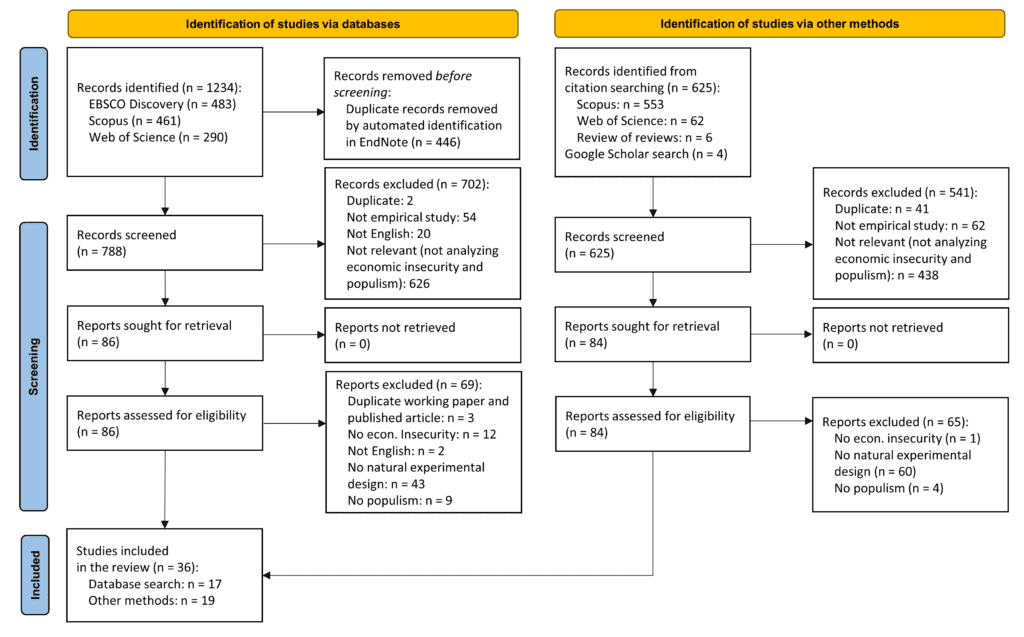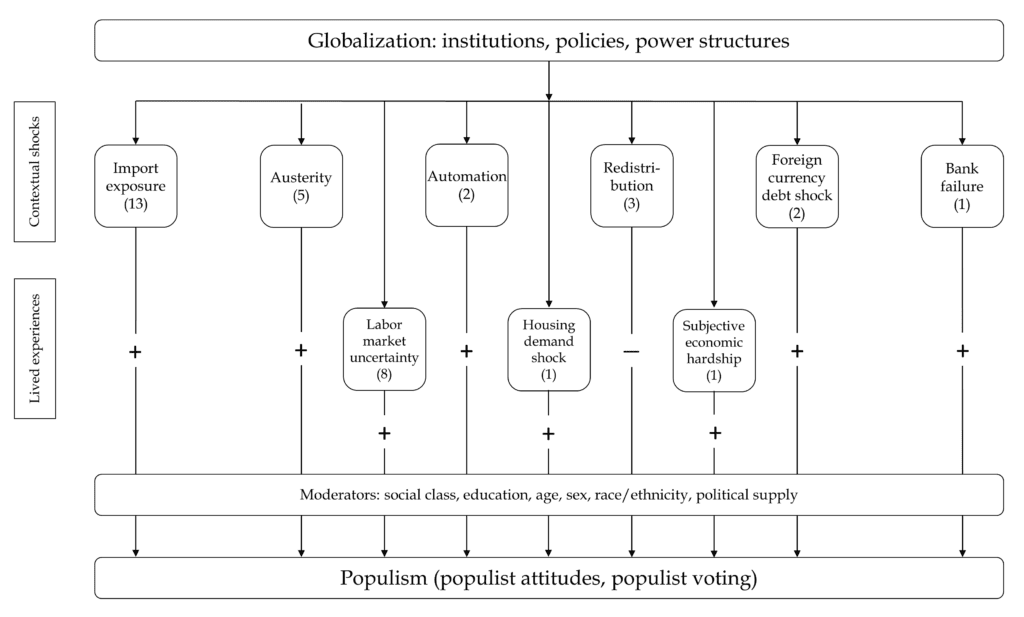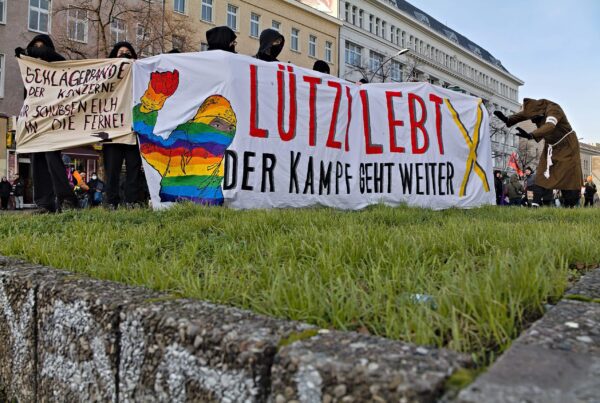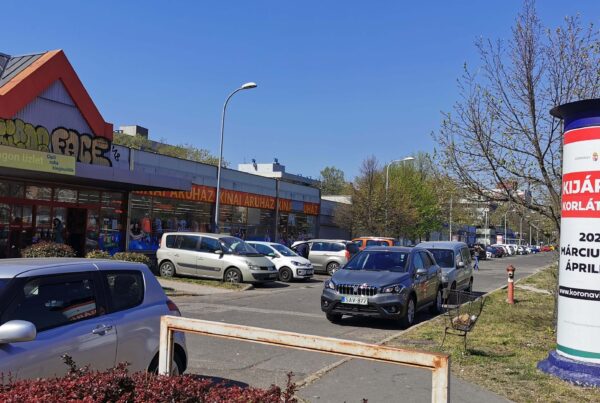Populism scholars cannot ignore the robust causal evidence on the disruptive political effects of economic insecurity and claim that economic factors play no role in populism. To beat right-wing populism, politicians and policymakers need to tackle economic insecurity.
An unresolved debate
The rise of populism is at the heart of the biggest debates in politics and the social sciences. An unresolved animating question is how the culture war and economic insecurity contribute to this populist backlash. Proponents of the cultural argument argue that populism is an adverse reaction to cultural progressivism and cosmopolitan values among less-educated white men, whose fears of status loss have nothing to do with material reality (see here, here, and here). Others contend that economic globalization, deindustrialization, the global financial crisis, and technological change result in economic insecurity, catalyzing populism (see here and here).
The dominant perception in the literature is that economic insecurity is not strongly related to populism. A recent narrative review concluded that “the evidence that those directly hurt by globalization are more likely to vote for anti-globalization parties or proposals is mixed.” Another narrative review reached a similar conclusion, highlighting that “the evidence linking individual economic grievances to populist voting is not particularly strong,” while “scholars consistently find strong connections between individuals’ views on sociocultural issues and right-wing populist voting.”
In short, while the research on populism could fill libraries, there is still a great deal of confusion about the role and relationship of the culture war and economic insecurity as catalysts of populism. Researchers often regard economic factors as secondary. This essay aims to bring some clarity to the discussion and establish common ground by reviewing and synthesizing the existing causal evidence on whether economic insecurity catalyzes populism.
Cutting through the fog: A systematic review of the literature
A systematic review has several benefits compared to classic narrative reviews. A systematic review “locates existing studies, selects and evaluates contributions, analyses and synthesizes data, and reports the evidence in such a way that allows reasonably clear conclusions to be reached about what is and is not known.” Narrative literature reviews — either stand-alone or as part of an empirical study — might reflect the priorities and conceptual framework of the researcher. By conforming to the standards expected of primary research, systematic reviews can significantly reduce bias, increase transparency, and be subject to replication. Because of its beneficial properties, a systematic review sits at the top of the evidence hierarchy.
In the collaborative research underlying this essay,[1] we followed a complex systematic search strategy as outlined in the Preferred Reporting Items for Systematic Reviews and Meta-Analyses (PRISMA) guidelines. We combined an academic database search with a backward citation search of the eligible studies and a review of recently published narrative reviews. We included studies that focus on populist political behavior as the outcome, economic insecurity broadly defined as treatment, and follow a quasi-experimental research design to identify causality.
Quasi-experimental studies “aim to make causal inferences about the effects of an exposure or intervention of interest on outcomes by exploiting exogenous variation in treatment assignment.” Although quasi-experiments cannot unequivocally prove the existence of a causal association, they do a better job than observational studies.
After screening and excluding ineligible papers, we reviewed and synthesized 36 studies fulfilling our inclusion criteria. The flow chart in Figure 1 describes the process and method of this systematic review following the PRISMA guidelines.

A bird’s-eye view of economic insecurity and populism
We found 36 studies that fulfilled our inclusion criteria, as summarized in Table 1 in the Appendix. All 36 studies report a robust causal link between economic insecurity and populism. A recurring effect size is that economic shocks and economic insecurity explain around one-third of recent surges in populism.
Based on the reviewed studies, Figure 2 presents an overview of the relationship between economic insecurity and populism. The numbers in brackets indicate the number of studies analyzing the association. Contextual-level shocks include import exposure, austerity, automation, redistribution, foreign currency debt, and bank failure. Labor market uncertainty, housing demand shock, parental unemployment, and subjective economic hardship are indicators of lived experiences. These can be both considered independent causes and mediators of the upstream shocks. Redistribution refers to a set of policies that can offset the negative health effect of economic insecurity, hence the negative sign.

The literature also identified important moderators, such as class, education, age, sex, race/ethnicity, political supply (the availability or lack of populist candidates for whom to vote, their political strategy, and the availability of alternatives) and social security policies. These moderators influence how economic shocks and subjects’ lived experiences translate into populism. Finally, the literature has identified two populist outcomes: cultural backlash and political behaviors. We concentrated our review on the latter. However, we found seven studies showing that cultural backlash mediates the effect of economic insecurity on populist political behavior. These studies show that the cultural backlash is in part a consequence of economic insecurity, and not a fully independent cause.
From economic shocks to populism
The import share from low-wage countries grew from 15% to 28% in the 2000s in the US, with China accounting for 89% of the increase. This “China shock” has wide-ranging consequences for American workers, leading to the closure of manufacturing plants, a drop in employment, and increasing declining life expectancy.
This China shock also has pervasive political implications. A path-breaking study showed that import exposure in the US in the 2000s led to an increase in the campaign contributions by more ideologically extreme donors on both sides of the spectrum, increased the popularity of conservative media (focusing on Fox News), and conservative viewpoints (measured by the Pew Ideology Score). Electoral districts with greater exposure to Chinese imports were more likely to elect Republican members of Congress after 2010 largely at the cost of moderate Democrats. They also saw a moderate increase in the vote share of Republican presidential candidates in the 2000-2008 period, and a strong increase in the 2008-2016 period. The study concludes that the net result of these political changes is that although more ideologically extreme members of both parties gain office, only the Republicans were able to gain more seats as a consequence of trade shocks.
Another highly influential paper analyzed the political impact of import exposure in 15 Western European regions from 1988 to 2007. Based on the Comparative Manifesto Project Database, the authors created a novel measure of the ideological orientation of each party. Their results show that the import shock in the period investigated fueled the support of the protectionist right but not of the protectionist left and led to a decline in the support for the pro-trade left. To assess the magnitude of their effect they calculated that a one-standard-deviation increase in the Chinese import shock led to a 1.7-percentage-point increase in the support for the radical right. This effect is substantial. The average radical-right vote share was 5% in Western Europe between 1988 and 2007, implying that one-third of the populist radical right’s votes were attributable to the import shock in Western Europe.
The same holds for the Brexit referendum in 2016. The “Leave” share of the vote was systematically higher in regions more exposed to the Chinese import shock. The import shock again explained around one-third of the Leave vote directly, and it also led to an increase in anti-immigration attitudes.
Labor market turmoil, such as increasing unemployment and job uncertainty, is also among the chief causes of populism. A highly-cited study showed that a 1-percentage-point increase in the unemployment rate during the Great Recession led to an increase in votes for populist parties by 2 to 4 percentage points across Europe. Again, the evidence suggests that unemployment also fueled cultural expressions of populism, such as political distrust and anti-immigration attitudes.
These labor-market uncertainties catalyze populism even in countries with strong welfare states, such as Sweden. A study found that the number of layoff notices received by low-skilled workers explained 31% of the total increase in votes for the radical-right Sweden Democrats between 2007 and 2010.
Technological advancement is another form of economic shock. Low-skilled workers whose jobs are easier to automate are losing out to digitalization and robotization. A study found that industrial robot adoption led to a 2.8-percentage-point increase in the probability of voting for a radical-right party in Europe in the 1999–2015 period. This effect is again large, since the baseline probability of voting for a radical right party in this period in the countries being analyzed in the study was 4.8%. Like other forms of uncertainty, robotization also increases nativism, status threat, and cultural traditionalism.
Low-wage countries are often considered winners of industries’ relocations from high-income countries; thus, import exposure and robotization likely play a minor role in populism in these countries. East-Central Europe[2] is home to archetypical foreign-investment-driven export economies relying on comparatively cheap labor. However, this does not mean that the region does not experience the negative consequences of domestic disintegration as its countries integrate into the global economy. Researchers just have to look at other processes than robotization or import exposure.
The foreign currency debt shock in Hungary is a great example. By 2008, more than 60% of household debt in Hungary was denominated in Swiss francs. Because of the financial crisis between September 2008 and the election held in April 2010, the exchange rate for the Hungarian forint against the Swiss franc depreciated by 23%. This depreciation led to a rapid, unexpected increase in household indebtedness. This foreign currency debt shock increased the vote share of the far-right Jobbik party by five percentage points on average, representing 35% of the total increase in the far-right vote share from 2006 to 2010 in Hungary.
Finally, austerity also has significant disruptive potential for fueling the rise of populism. For example, people exposed to welfare cuts were more likely to support the United Kingdom Independence Party (UKIP) and support the Leave campaign in 2016. A study found that UKIP vote shares increased by between 3.5 and 11.9 percentage points due to austerity. “Leave” support in 2016 would have been at least six percentage points lower without austerity, thus leaving the UK within the European Union.
How does demand driven by economic shocks interact with political supply?
In contrast to austerity, redistribution dampens voters’ enthusiasm for populism. At the same time, institutional arrangements that prevent governments from protecting social cohesion in hard times magnify the effect of economic insecurity on populism. The rise of economic insecurity and populism are thus not natural laws inherent to globalization. They are consequences of policy choices. Redistributive policies can reduce economic insecurity and take the wind out of populists’ sails. As one study concluded, “if one wants to defeat populism, one must first defeat economic insecurity.”
Changes in political supply influence how economic insecurity translates into political outcomes. For example, once the Five Star Movement appeared in Italy, it successfully attracted the votes of trade victims previously channeled by radical-right parties. Thus, when presented with an alternative, victims of trade shocks do not necessarily choose a radical-right populist party.
The US offers an opposite example. Here, Democrats had benefited from the discontent of trade victims during the presidential elections before 2012, with 2012 being something of a wash between the two, a turning point. However, since 2012, Republicans have since become more successful in attracting the victims of trade shocks, leading to Trump’s 2016 victory. Center-left parties are particularly vulnerable to moving toward the right in economic policy; their voters might leave them, become passive, or turn to radical alternatives.
Voters’ ideological orientation might differ from their actual voting behavior. There is causal evidence that economic insecurity induced a slight leftward shift in ideological orientation among trade victims in Europe. However, they were more likely to vote for radical-right parties than voters not exposed to import competition. Trade victims might embrace anti-liberal right-populist political views due to political supply-side effects stemming from radical-right populists. In other words, a significant part of the radical-right voting bloc is not made up simply of committed racists, but includes those who would be open to a left-wing alternative to centrist liberalism if it existed. If such an option does not exist, these voters drift to the populist right.
This finding is in line with qualitative research on the cultural political economy of the globalization backlash. If progressive cultural identities are legitimately available, victims of globalization can use them to build political identities centered on solidarity. However, if such codes lose legitimacy, nationalism might emerge as an exclusionary solidarity community, filling the void left behind by the retreat of class-based progressive solidarity identities (see here, here, here, and here).
Does economic insecurity fuel the cultural backlash?
There is robust evidence that the cultural backlash is not an alternative mechanism but a mediator. Robotization increases nativism, status threat, and cultural traditionalism in Europe. Unemployment leads to political distrust.[3] Import exposure in the US increases the popularity of conservative media and conservative viewpoints and catalyzes the cultural backlash, which favors the success of the populist right. A social-psychological experimental survey showed that economic decline induces cultural discontent mediated by economic anger. Cultural discontent, in turn, catalyzes populism.
Crucially, there is also strong evidence that economic insecurity leads to a shift towards anti-liberal values in the domain of politics, but not in the extra-political domain such as child-rearing. This result implies that the populist backlash is neither a result of a persistent authoritarian outlook (“dysfunctional working-class culture”) nor an expression of a general shift in the direction of the authoritarian personality. Instead, the skepticism towards liberal values and liberal democracy is a political manifestation of distress driven by economic insecurity.
Some voters interpret economic grievances primarily concerned with their group’s status and not their individual self-interest. This is in line with the argument that culture-war-type political preferences are indirect reflections of economic shocks. At the same time, some studies identified a robust causal role of real suffering behind populism, such as declining life expectancy. This suggests that economic insecurity and individual material interests also directly affect populism.
Conclusions
This systematic review of the causal evidence of the role of economic insecurity behind populism showed undeniably strong evidence for the independent causal role of economic shocks in the populist backlash. Furthermore, many studies found that the cultural backlash itself is an expression of economic grievances. Several papers highlighted that policies and political supply factors influence if and how these economic shocks get translated into populist politics. Populism scholars cannot ignore the robust causal evidence on the disruptive political effects of economic insecurity and claim that economic factors play no role in populism.
It is also essential to recognize that economic shocks might affect people through several contextual and individual channels. Income loss is only one of them. Thus, studies that show little or no association between individuals’ position in the social distribution of incomes and populism should not be interpreted as evidence that economic grievances do not matter. Economic shocks lead to the destruction of communities, growing inequalities, the outmigration of the young and capable, and rising labor market uncertainty; these processes adversely affect whole neighborhoods (see here and here).[4] Living in such areas might catalyze populism even among those who do not lose their jobs or suffer income loss. Researchers need fine-grained tools to capture the effect of such economic shocks beyond the most widely used survey instruments.
Some voters are driven to populism solely because of cultural concerns or ingrained racism. However, a more diverse group of dissatisfied voters behind the recent surge of populism is primarily motivated by economic insecurity. The victims of economic shocks and those suffering from economic insecurity go beyond the poorest and most disadvantaged, encompassing a large part of what is often considered the middle class both in the US and Europe (see here and here). The success of far-right parties depends on their ability to mobilize a coalition of core base voters with cultural grievances and the often larger group of voters with economic grievances (see here and here). This implies that the strict dualism pervading the literature that juxtaposes interest-based economic determinants and symbolic cultural factors is not fruitful.
Policy choices and political supply influence voters’ reactions to economic dislocations. In the absence of left-wing, progressive policies and narratives, radical-right populists can mobilize dissent by fanning the flames of the culture war, using the nation as an imagined solidarity community that purports to protect against globalization. Right-wing populists make economic issues appear to be cultural ones. As a political supply-side tool, culture and identity are the dominant tropes of populism. But on the demand side, economic insecurity plays a critical role beyond the core group of committed racists and bigots. The cultural backlash is not a fully independent mechanism but, in part, a result of economic dislocations. In short, the headlines might be about race, religion, or nation, but the subtext is often about unaddressed issues of class (see here, here, here, and here).
Research should go beyond the strict juxtaposition of culture versus the economy and focus instead on the lived experiences of economic insecurity and the co-evolution of cultural-symbolic and economic factors. To beat right-wing populism, politicians and policymakers need to learn from the emerging evidence reviewed in this study. Instead of trying to take the wind out of radical-right populists’ sails by diluting left-wing platforms with chauvinism, social democrats should address economic insecurity. The existing evidence suggests that they could achieve this by offering new forms of redistribution and a progressive narrative identity to reintegrate the victims of economic shocks into mainstream politics.
Acknowledgements
This essay is based on a research manuscript co-authored with Manuel Serrano-Alarcón, Alexandru Moise, Courtney McNamara, and David Stuckler. I am grateful for the help of my collaborators. This project has received funding from the European Union’s Horizon 2020 research and innovation program under the Marie Skłodowska-Curie grant agreement No 890187.
APPENDIX
TABLE 1. Overview of the causal evidence on economic insecurity and populism
| Study | Setting | Outcome & operationalization | Treatment | Design | Summary of results |
| Ahlquist et al. (2020) | Poland, 2015 | Populist radical right; Vote choice; Binary | Foreign currency debt shock | Survey experiment; Matching; | Individuals exposed to the 2015 surprise revaluation of the Swiss franc were more likely to demand government support and more likely to vote for the largest opposition party, the national-populist PiS. |
| Albanese et al. (2022) | Italy, 2008–2013 | Populist radical right & Left; Political orientation; Score | Redistribution | Reg. discont.; Instrumental variable | Higher EU financing in the 2008–2012 period led to lower support for populist parties in the 2013 general election. |
| Algan et al. (2017) | European Union, 2000–2016 | Populist radical right & left; Vote share; Change | Labor market uncertainty | Instrumental variable; Diff-in-diff | There is a strong relationship between increases in unemployment and voting for non-mainstream parties, especially populist ones. |
| Anelli et al. (2021) | Western Europe, 1999–2015 | Populist radical right; Vote choice; Binary | Automation | Instrumental variable | Individuals exposed to automation display higher support for the radical right, independently of cultural factors. Automation also increases nativism, status threat, and cultural traditionalism. |
| Autor et al. (2020) | US, 2000–2016 | Populist radical right; Vote share; Change | Import exposure | Instrumental variable | Import exposure increased the campaign contributions by more ideologically extreme donors, the popularity of conservative media, conservative viewpoints, Republican nominees after 2010, and Trump in 2016. |
| Baccini and Sattler (2021) | Western Europe, 1991-2018 | Populist Radical Right & Left; Political orientation; Score | Austerity | Difference-in-Differences | Austerity increases support for radical-right populism in economically vulnerable regions. Furthermore, it catalyzes a cultural backlash: negative attitudes against migrants and minorities, higher support for conservative values. |
| Baccini and Weymouth (2021) | US, 2004-2016 | Populist Radical Right; Vote share; Change | Labor market uncertainty | Instrumental variable | White manufacturing layoffs led to a decline in the Clinton vote and an increase in the Trump vote, while Non-White manufacturing layoffs had the opposite effect during the 2016 Presidential election. |
| Barone and Kreuter (2021) | Italy, 1992–2013 | Populist radical right & left; Vote share; Change | Import exposure | Instrumental variable | Trade globalization increased support for populist parties and invalid votes, and abstentionism. Redistribution mitigated the political consequences of the trade shock because it alleviated economic distress. |
| Barros and Santos Silva (2019) | Brazil, 2014–2018 | Populist radical right; Vote share; Change | Labor market uncertainty | Instrumental variable | Male-specific labor market shocks increase support for Pres. Jair Bolsonaro, while female-specific shocks have the opposite effect. |
| Caprettiniet al. (2021) | Italy, 1946–1992 | Populist radical left; Vote share; Change | Redistribution | Reg. discont.; Instrumental variable | The large-scale land redistribution led to persistent electoral benefits for the Christian Democrats (DC), the party that promoted the reform, and persistent electoral losses for the Communist Party (PCI). |
| Caselli et al. (2020) | Italy, 1994–2008 | Populist radical right; Vote share; Change | Import exposure | Instrumental variable | Exposure to import competition from China has positively contributed to the electoral outcomes of far‐right parties. |
| Caselli et al. (2021) | Italy, 2001–2013 | Populist radical right & Left; Vote share; Change | Import exposure | Instrumental variable | Import exposure, robotization, and immigration increased the votes for far‐right parties between 2001 and 2008. After 2008, only robotization had such an impact, while immigration increased the votes for the 5 Star Movement. |
| Cavaille and Ferwerda (2022) | Austria 2002-2006 | Populist Radical Right; Vote share; Change | Housing demand shock | Difference-in-Differences | Municipalities most exposed to public housing congestion induced by the extension of public housing benefits to non-EU residents led to a significant increase in radical right votes |
| Chen (2020) | US, 2006–2014 | Populist radical right & Left; Vote share; Level | Labor market uncertainty | Diff-in-diff; Matching | Unemployment during the Great Recession increased distrust in companies, the preference for redistribution, and voting for Sanders in primaries. Immigrant influx increased anti-immigration attitudes and voting for Trump. |
| Colantone and Stanig (2018a) | Western Europe, 1988–2007 | Populist radical right; Political orientation; Score | Import exposure | Instrumental variable | A stronger import shock leads to (1) an increase in support for nationalist and isolationist parties, (2) an increase in support for radical-right parties, and (3) a general shift to the right in the electorate. |
| Colantone and Stanig (2018b) | Western Europe, 1988–2008 | Populist attitudes; Political orientation; Score | Import exposure | Instrumental variable | Import shocks lead to less democratic and liberal, and more authoritarian, attitudes. People in regions with stronger import shocks are more concerned with the “cultural threat” posed by immigrants. |
| Colantone and Stanig (2018c) | UK, 1990–2007 | Populist radical right; Vote share; Level | Import exposure | Instrumental variable | The “Leave” share in the Brexit referendum was systematically higher in regions more exposed to the Chinese import shock. Import exposure also led to an increase in anti-immigration attitudes. |
| Crescenzi et al. (2020) | UK, 2016 | Populist radical right; Vote share; Level | Redistribution | Regression discontinuity | Citizens living in areas eligible for the highest amount of EU Structural Funds and experiencing improvements in their labor market were more inclined to express a pro-Europe (“Remain”) vote in the referendum on Brexit. |
| Dehdari (2022) | Sweden, 2006–2010 | Populist radical right; Vote share; Change | Labor market uncertainty | Instrumental variable | The study finds that one layoff notice among low-skilled native-born workers increases, on average, support for the Swedish radical-right party, the Sweden Democrats, by 0.17–0.45 votes. |
| Dippel et al. (2021) | Germany, 1987–2009 | Populist radical right; Vote share; Change | Import exposure | Instrumental variable | Exposure to imports from low-wage countries increased the support for the far-right between 1987 and 2009. Low-skilled manufacturing workers were the most affected. There is no robust association with the far-left vote shares. |
| Doerr et al. (2022) | Germany, 1930–1932 | Populist radical right; Vote share; Change | Bank failure | Diff-in-diff; Matching | Danat Bank’s failure (targeted by anti-Jewish propaganda) led to declining incomes & increased Nazi votes. Dresdner Bank’s failure (no Nazi propaganda) had similar income effect but no increase in Nazi votes. |
| Ferrera (2022) | US, 2008–2016 | Populist radical right; Political orientation; Score | Import exposure | Instrumental variable | Voters living in districts more exposed to Chinese imports are more likely to favor racial and religious in-groups (Whites and Christians) against ethnic, religious, and sexual minorities, and vote for the Republican Presidential candidate. |
| Fervers (2019) | Germany, 2003 | Populist radical right & left; Vote choice; Binary | Austerity | Regression discontinuity | The Harz IV reforms led to decreasing satisfaction with democracy and political participation, as well as increasing support for non-established right-wing parties and non-established left-wing parties less robustly. |
| Fetzer (2019) | UK, 2000–2016 | Populist radical right; Vote share; Multiple | Austerity | Diff-in-diff; Event study | Electoral district and individual-level results suggest that those exposed to welfare cuts experienced large and precisely estimated increases in their tendency to express support for UKIP and support “Leave” in the 2016 Brexit referendum. |
| Fetzer et al. (2022) | UK, 2008–2016 | Populist radical right; Vote share; Level | Austerity | Diff-in-diff; Matching | Housing benefits cut led to an affordability shock and significant housing insecurities. It also decreased the registration and turnout in the 2016 EU referendum and increased the support for “Leave.” |
| Frey et al. (2018) | US, 2011–2015 | Populist radical right; Vote share; Change | Automation | Instrumental variable | Victims of the robot revolution have a higher propensity to opt for radical political change: electoral districts with higher exposure to robots were significantly more likely to support Trump. |
| Galofré-Vilàet al. (2021) | Germany, 1930–1933 | Populist radical right; Vote share; Change | Austerity | Instrumental variable; Reg. discontinuity | Areas more affected by austerity had higher Nazi vote shares. Most of the effect of austerity is driven by health and housing expenditure cuts. Mortality is a significant mediator of the effect of austerity on Nazi Party support. |
| Gozgor (2021) | European Union, 1980–2020 | Populist radical right & left; Vote share; Change | Labor market uncertainty | Instrumental variable | Higher economic uncertainty measured by the World Uncertainty Index increases support for total populism, right-wing populism, and left-wing populism to a smaller degree. |
| Guiso et al. (2019) | European Union, 2000–14 | Populist radical right; Vote share; Level | Import exposure | Instrumental variable | Import exposure and the financial crisis have boosted populism in Eurozone (EZ) countries but not in non-EZ countries. The policy straitjacket imposed by the EZ increases economic insecurity, which fuels populism. |
| Gyongyosi and Verner (2022) | Hungary, 1998–2014 | Populist radical right; Vote share; Multiple | Foreign currency debt shock | Instrumental variable; Diff-in-diff | Household debt increase due to the foreign currency exchange rate shock was a significant cause behind the electoral success of the radical-right Jobbik party in Hungary in 2010. |
| Lechler (2019) | European Union, 1994–2014 | Populist radical right; Vote share; Change | Labor market uncertainty | Instrumental variable | Declining employment increases Eurosceptic voting. This effect is particularly strong for unemployed and low-skilled workers in regions with a high share of migrants from other EU member states. |
| Lin and Xi (2022) | European Union, 2010-2014 | Populist Radical Right; Vote share; Change | Import exposure | Instrumental variable | Exposure to the import shock from developing countries increases the support for right-wing parties and economically far right parties, but decreases the support for culturally far right parties. |
| Malgouyres (2017) | France, 1995–2012 | Populist radical right; Vote share; Change | Import exposure | Instrumental variable | Industrial decline generated by import exposure increases far-right vote share. The effect increased over time, benefitting the far-right mainly during the period from 2007–2012. |
| Milner (2021) | Western Europe, 1990–2018 | Populist radical right & left; Vote share; Level | Import exposure | Instrumental variable | Import exposure and automation are associated with growing vote shares for extreme right parties. The financial crisis enhanced support for populist right parties and eroded support for mainstream left parties. |
| Neundorf and Pardos-Prado (2021) | US, 2020 | Populist radical right; Vote choice; Binary | GDP decline | Survey experiment | The negative economic impact of covid-19 contributed to Trump’s electoral defeat in 2020. |
| Rhodes-Purdy et al. (2021) | US, 2020 | Populist attitudes; Political orientation; Score | Subjective economic hardship | Survey experiment | Negative economic priming induced cultural discontent. Anger mediates the effect of economic decline on cultural discontent. Cultural discontent, in turn, catalyzes populism. |
| Siedler (2011) | Germany, 1990–2004 | Populist radical right; Vote choice; Change | Labor market uncertainty | Sibling differences | Parental unemployment during late childhood has a significant positive effect on right-wing party affinity later in life. |
[1] Gabor Scheiring, Manuel Serrano-Alarcón, Alexandru Moise, Courtney McNamara, and David Stuckler, “The Populist Backlash against Globalization: A Systematic Review of the Causal Evidence That Economic Insecurity Is a Catalyst of Populism,” 2022, Manuscript, Dondena Research Center, Department of Social and Political Sciences, Bocconi University, Milan, Italy.
[2] East-Central Europe is the region between German-, Hungarian-, and West Slavic-speaking Europe and the East Slavic countries of Belarus, Russia, and Ukraine.
[3] Andrea Cerrato, Federico Maria Ferrara, and Francesco Ruggieri, “Why Does Import Competition Favor Republicans?,” (unpublished manuscript, September 30, 2018), available at http://dx.doi.org/10.2139/ssrn.3147169.
[4] Anne-Marie Jeannet and Chiara Allegri, “Has Regional Deindustrialization Decreased People’s Satisfaction with Democracy?,” (Society for the Advancement of Socio-Economics Annual Conference, July 20, 2020.
Photo: “Occupy Wall Street,” by Boris D. Leak licensed under CC BY-SA 4.0.







